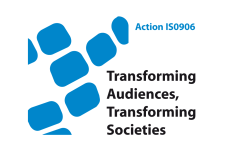- About the Action
- Events
- PhD workshop - Ljubljana 2014
- Action Open Conference - Ljubljana 2014
- New Media and Participation conference - Istanbul 2013
- Belgrade meeting 2013
- Media literacy research and policy - Brussels 2013
- ICA Pre-Conference 2013
- Tampere meeting 2013
- Budapest workshop 2012
- Milan meeting 2012
- Brussels PhD workshop 2012
- Brussels Action workshop 2012
- London meeting 2011
- Zagreb Conference 2011
- Lisbon meeting 2010
- Affiliated events
- WG 1
- WG 2
- WG 3
- WG 4
- Cross-WG
- Output
The challenges of new media and renewal in the traditional medium of radio: the benefits of passivity
Starkey, G. (2011). The challenges of new media and renewal in the traditional medium of radio: the benefits of passivity . Zagreb conference: "New challenges and methodological innovations in European media audience research". 7-9 April 2011.
Abstract: In this digital age, we are becoming accustomed to media convergence, and the challenges faced by old media multiplying as technological change presents audiences with ever more choice. We are equally used to interactivity in all its many forms and the sense of empowerment this may give audiences. But with so much media output to choose from, how will different media develop, and how will audiences use them? Today, there are ever more ‘active’ media, and they are becoming increasingly interactive. But what of ‘passive’ media? One medium which can be as active as all the others is radio, but it can also be consumed passively. That is one of its great strengths, and perhaps a reason why radio may be one of the most durable of today's media as we head towards an uncertain future. This paper considers how new challenges have affected radio, as a medium with a hundred-year history. It sets current ways in which audiences consume radio programming in the context of the interactive and ‘new’ media revolution. It also explains why the ways in which audiences perceive radio lend it a uniqueness that derives from its secondary nature: one perceived by Crisell (1994) not as a weakness but as a strength. It also presents empirical audience research data to suggest future scenarios for the medium of radio.

